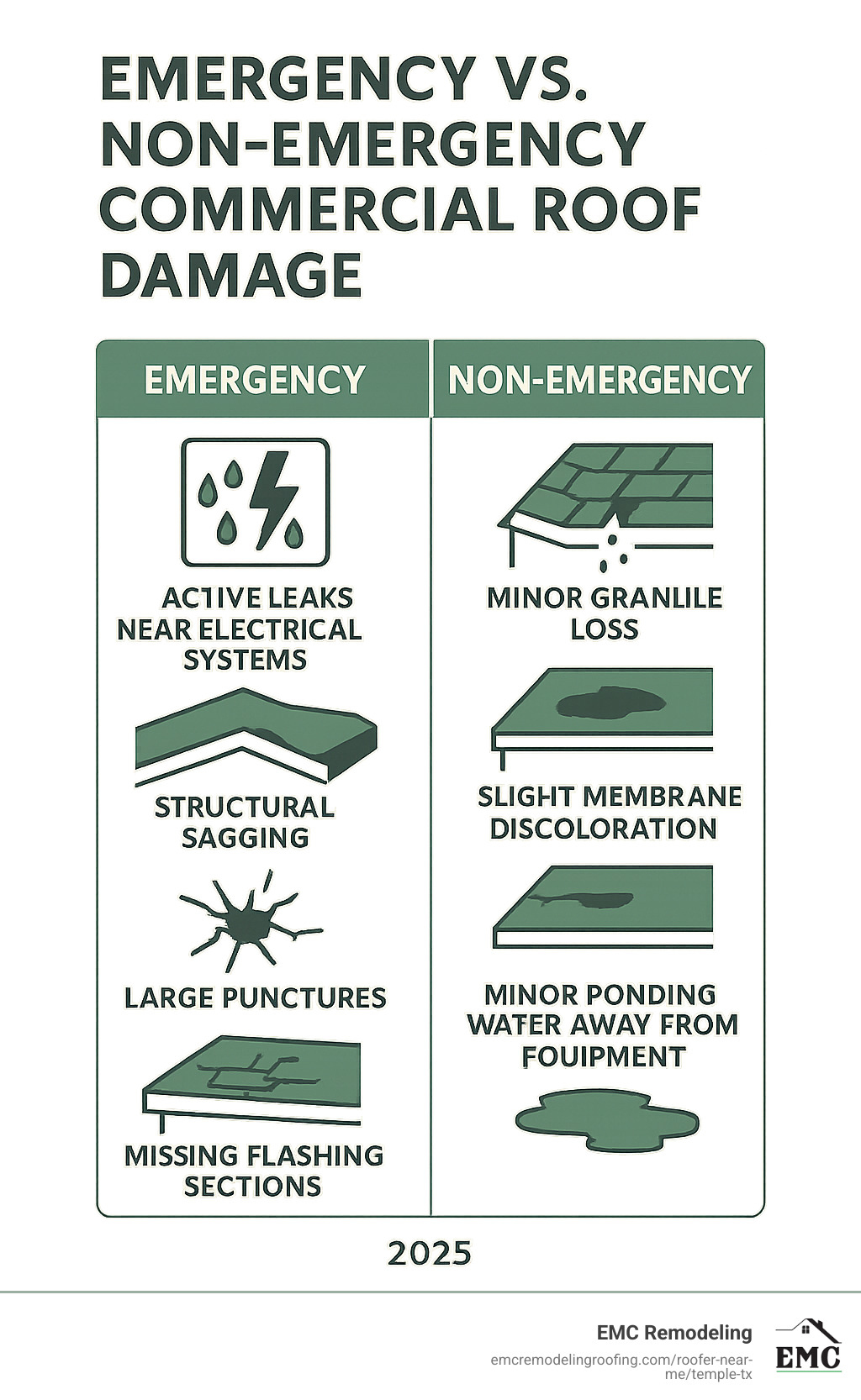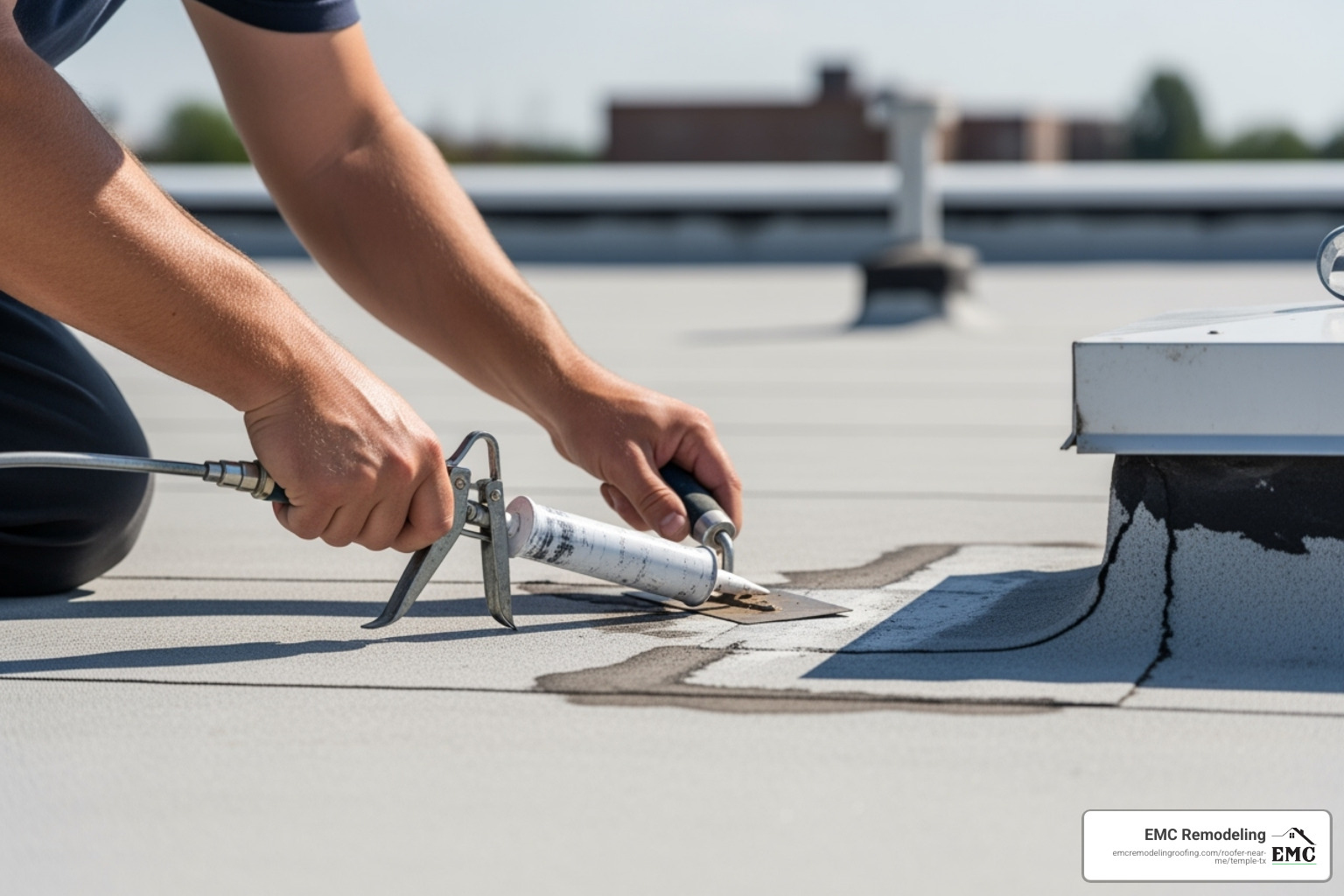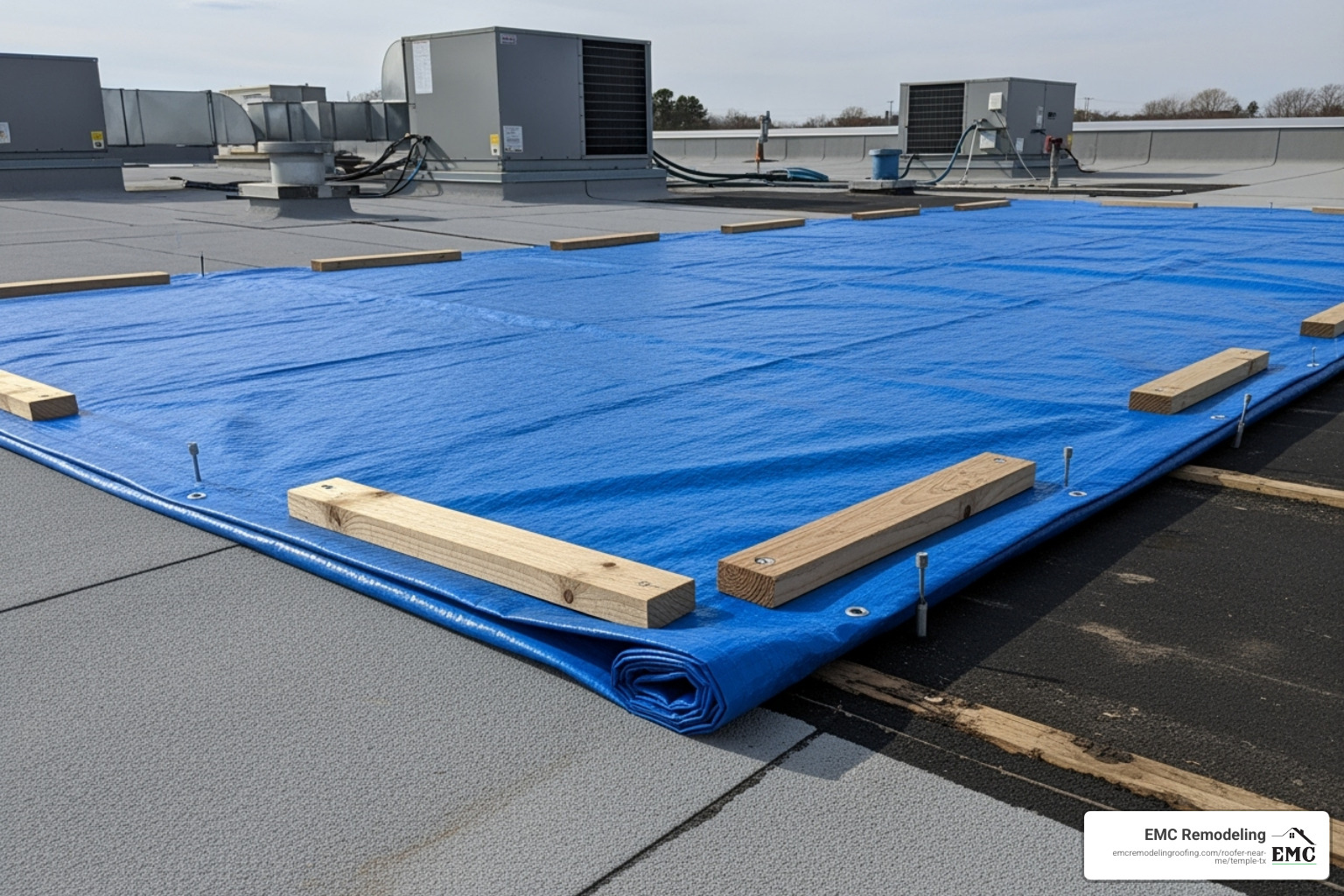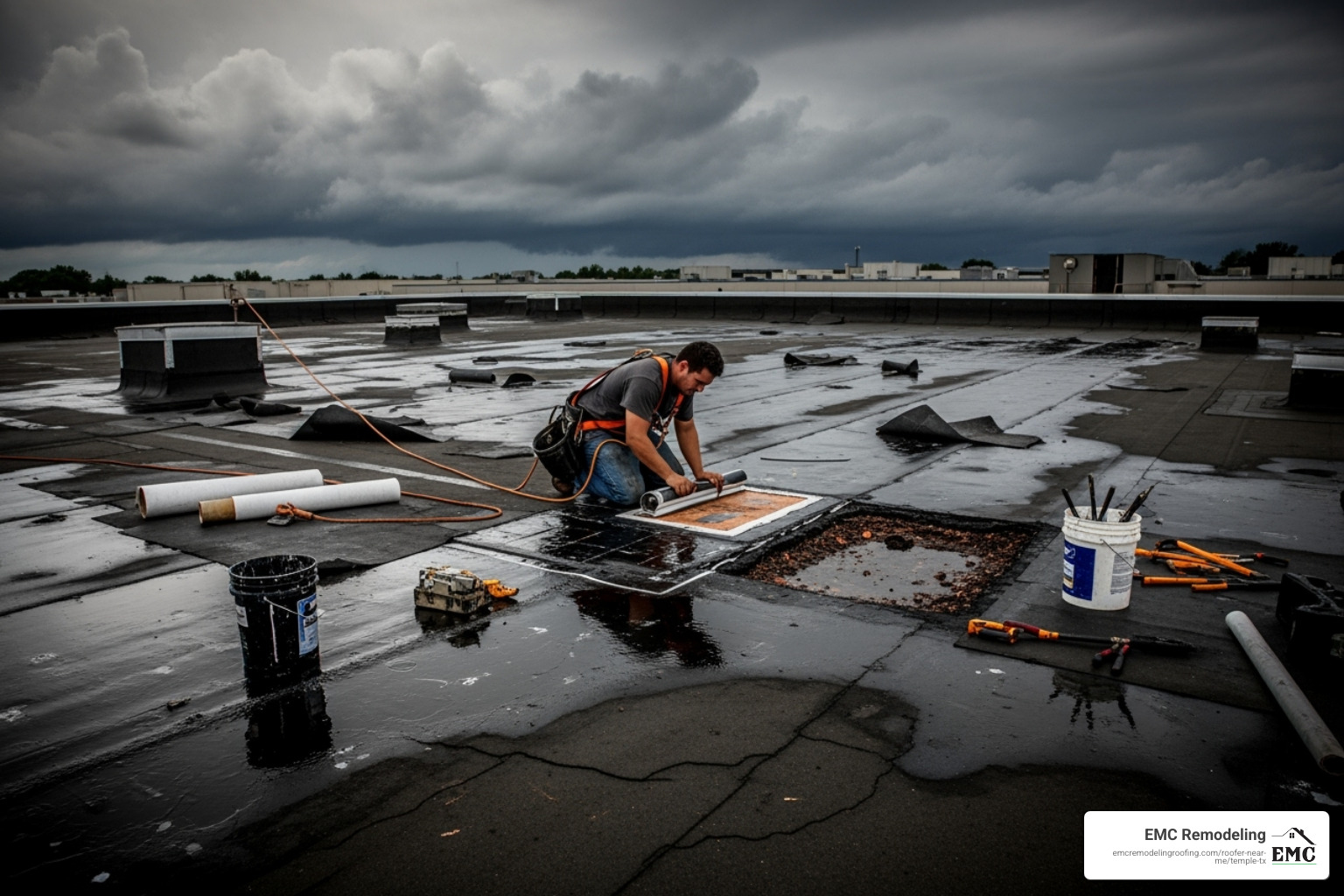When Every Minute Counts: The Critical Nature of Commercial Roof Emergencies
When a commercial roof fails, emergency roof patching becomes the difference between minor water damage and catastrophic business losses. A sudden leak can halt operations within hours, damage thousands of dollars in inventory, and create liability issues that put your entire enterprise at risk.
Quick Emergency Roof Patching Steps:
- Assess safety – Check for electrical hazards and structural damage
- Document damage – Take photos for insurance claims
- Secure the area – Clear debris and gather materials
- Apply temporary patch – Use tarps, sealant, or membrane patches
- Call professionals – Schedule permanent repairs immediately
The statistics are sobering: severe weather causes billions in commercial property damage annually, with high winds, hail, and falling debris causing 60% of roof emergencies. According to the Federal Alliance for Safe Homes, fixing emergencies early saves 30-50% on total repair costs.
For Central Texas business owners, knowing how to perform immediate damage control with a trusted local roofing company can mean the difference between a quick fix and months of costly downtime.
I’m Matt Runyon, President of EMC Remodeling, and over my 15+ years in the roofing industry, I’ve seen how proper emergency roof patching can save businesses from devastating losses. My experience with storm damage restoration across Central Texas has taught me that the first hour after roof damage occurs is often the most critical for protecting your investment.

Is It a Drip or a Disaster? Defining a True Roofing Emergency
When we talk about a commercial roofing emergency, we’re not just talking about a minor drip. We’re referring to situations where your building’s interior or operations are immediately threatened by roof damage. This can include anything from severe leaks that are actively pouring water into your facility, to large punctures from falling debris, or significant wind-driven damage that has exposed the underlying structure. Missing flashing, structural sagging, and even the widespread impact of hail can all trigger a commercial roofing emergency. The key indicator is the potential for rapid, significant damage or business interruption.
Signs of Critical Damage on Commercial Roofs
How do you know if you’re facing a true roofing emergency? Look for these critical signs:
- Active Water Intrusion: This is the most obvious sign. If water is actively dripping, pouring, or pooling inside your building, especially near electrical systems or valuable equipment, it’s an emergency.
- Visible Holes or Punctures: A clear opening in your roof membrane or panels means immediate exposure to the elements.
- Torn Roofing Membrane: Large tears in flat roof membranes (like TPO, EPDM, or PVC) can allow significant water entry.
- Damaged HVAC Curbs: If the flashing or structure around your rooftop HVAC units is compromised, water can easily bypass the roof system.
- Loose or Bent Metal Panels: On metal roofs, bent or dislodged panels can create large openings for water and compromise structural integrity.
- Creaking or Sagging Roof Deck: These are serious structural warning signs that indicate immediate danger and potential collapse.
- Water Pooling Near Electrical Systems: This is an extreme hazard that could lead to electrical shorts, fires, or electrocution.
If you observe any of these, swift action is paramount.
The High Cost of Delay
Ignoring or delaying an emergency roof patching can lead to a cascade of problems that are far more costly than the initial repair. We’ve seen how quickly things can escalate:
- Inventory Damage: Water can ruin products, raw materials, and finished goods, leading to substantial financial losses.
- Equipment Failure: Water infiltration can short-circuit machinery, computers, and other critical equipment, causing expensive repairs or replacements and operational downtime.
- Structural Rot: Prolonged water exposure leads to wood rot in the roof deck, beams, and even wall structures, compromising the entire building’s integrity.
- Toxic Mold Growth: Within 24-48 hours, water damage can spur the growth of toxic mold, leading to unhealthy indoor air quality, potential health issues for occupants, and costly remediation.
- Electrical Hazards: Water and electricity are a dangerous mix. Leaks near wiring or electrical panels pose severe risks of fire and electrocution.
- Potential Liability: If customers or employees are injured due to a roof-related hazard (e.g., slip and fall on wet floors), your business could face significant liability.
This isn’t just about saving your roof; it’s about protecting your entire business.
Don’t Make a Bad Situation Worse: Essential Safety Protocols Before You Patch
I can’t stress this enough: emergency roof patching safety protocols aren’t suggestions—they’re life-saving requirements. In my 15+ years working on Central Texas roofs, I’ve seen too many well-intentioned business owners turn a manageable emergency into a tragedy by rushing onto a damaged roof without proper precautions.

The first rule? Wait for calm weather. I know water is pouring through your ceiling, but attempting roof work during active storms, high winds, or heavy rain is asking for disaster. Wet commercial roofs become ice rinks—even experienced professionals avoid them during bad weather. Your temporary patch won’t hold if you can’t safely apply it.
Before anyone sets foot on that roof, you need to assess structural stability from the ground. Look up from a safe distance. Do you see visible sagging, large cracks, or hear any creaking sounds? If yes, evacuate the building immediately and call both emergency services and professional roofers. A collapsed roof doesn’t care how urgent your repair feels.
Electrical hazards are silent killers in roof emergencies. If you spot downed power lines anywhere near your building, or water pooling near electrical outlets or circuit boxes, stop everything. Call 911 and your utility company first. If it’s safe to access your main electrical panel, turn off power to the affected area. Water and electricity have ended too many emergency repairs permanently.
The proper safety gear isn’t optional equipment—it’s your insurance policy. Non-slip work boots provide crucial traction on commercial roof surfaces. Safety glasses protect your eyes from flying debris and sealant splashes. Heavy-duty gloves prevent cuts from sharp metal edges or broken materials. Most importantly, a safety harness and rope system are absolutely essential for commercial roof work. The fall from a commercial building can be fatal.
Never work alone on a damaged roof. Always have at least one person on the ground who can assist, monitor conditions, and call for help if something goes wrong. This partner can also hand up materials, reducing your time on the dangerous surface.
Establishing a safe access point means using a sturdy, properly secured ladder that extends at least three feet above the roof edge. The ladder should be angled at a 4:1 ratio—for every four feet of height, the base should be one foot away from the building. Always maintain three points of contact when climbing, and never overreach once you’re up there.
Essential Gear for a Temporary Patch
Having the right materials staged and ready can mean the difference between a quick, effective patch and a dangerous scramble during an emergency. Smart business owners keep these supplies accessible before they need them.
Your heavy-duty waterproof tarp should be EPDM or polyethylene material, significantly larger than any potential damage area. Look for tarps with UV inhibitors—Central Texas sun can degrade cheap tarps in weeks. A quality tarp can protect your building for months if needed.
Roofing cement or wet-patch sealant designed for wet applications can stop active leaks even on damp surfaces. These products are lifesavers when you can’t wait for surfaces to dry completely. Keep both a bucket of roofing cement and several tubes of wet-patch sealant on hand.
Plywood sheets and 2×4 lumber serve as your anchoring system for tarps and provide solid backing for patches. Pre-cut these to manageable sizes—you don’t want to be wrestling with full sheets on a windy roof. Galvanized roofing screws with washers hold much better than nails and won’t rust out before permanent repairs arrive.
Your tool kit should include a sharp utility knife for cutting materials, a putty knife for spreading sealants evenly, and a caulking gun for tube-based products. These simple tools make the difference between a professional-looking temporary repair and a sloppy mess that might not hold.
These emergency supplies are designed to buy you time until our professional team at EMC Remodeling can arrive for permanent repairs. A well-executed temporary patch protects your property and keeps your business running while we prepare the proper solution.
Stopping the Flood: Your Step-by-Step Guide to Emergency Roof Patching
Once you’ve established safety protocols and gathered your essential gear, it’s time to tackle the emergency roof patching itself. We’re not trying to win any beauty contests here – we’re buying time and stopping water damage until professional help arrives.

The process starts with detective work. Locate the leak source by working from the inside out – look for water stains, active drips, or even daylight sneaking through where it shouldn’t be. On the roof, you’ll be hunting for missing materials, punctures, or compromised flashing around vents and equipment.
Next, clean debris from the area thoroughly. This isn’t just about making things look neat – a clean surface is crucial for proper adhesion. Remove loose debris, standing water, and dirt from around the damaged section. If possible, dry the surface using rags or a squeegee. While some emergency sealants work on wet surfaces, a drier area gives you a much better bond.
Before you touch anything else, document the damage with photos. Take clear shots from multiple angles – your insurance adjuster will thank you later, and it helps our team understand what we’re dealing with when we arrive for permanent repairs.
Now comes the actual patching work, which varies significantly depending on your roof type. Apply the patch following the specific methods below, then secure it firmly to withstand whatever weather Central Texas throws at it next.
Effective emergency roof patching for flat roofs (TPO, EPDM, PVC)
Flat commercial roofs are workhorses, but they’re vulnerable to punctures and seam failures – especially during our notorious Texas hail storms.
Start by identifying the exact puncture or tear. Sometimes what looks like one problem is actually multiple small issues clustered together. Clean the area with a compatible solvent – if you don’t have manufacturer-recommended cleaners handy, at least use a clean, dry rag to remove all dirt and oils from around the damage.
For smaller holes, apply a peel-and-stick patch or rubberized membrane designed specifically for your roof type. These patches are lifesavers because they’re designed to work quickly. Press the patch down firmly, then use a roller to ensure strong adhesion. Work from the center outwards to eliminate air bubbles – think of it like applying a giant band-aid.
Seal the edges with compatible lap sealant by applying a continuous bead around the entire perimeter of your patch. This creates that crucial watertight barrier. For extensive damage, forget the small patches – you’ll need to move to the tarping method we’ll cover below.
Patching Metal Commercial Roofs
Metal roofs are tough customers, but they can still suffer from punctures, bent panels, or loose fasteners – particularly when debris becomes airborne during storms.
Clean the damaged panel first, removing any rust, dirt, or debris. A wire brush works wonders here if you have one. Apply a vinyl patch over dents or holes by cutting your patch material large enough to overlap the damage by several inches on all sides. The bigger the overlap, the better your seal.
Seal the patch edges with caulk designed for metal roofing – this isn’t the time to use whatever tube of caulk you found in the supply closet. Metal roofs expand and contract with temperature changes, so you need a flexible, waterproof product that can handle the movement.
Finally, tighten any loose screws in the surrounding area. Often, the visible damage is just part of the story – nearby fasteners may have loosened during the same event that caused the main problem. Replace stripped screws with new, larger-gauge ones if needed.
These methods will get you through the immediate crisis, but they’re temporary solutions. For lasting repairs that come with warranties, our professional roof repair services provide the permanent fix your commercial property needs.
Securing a Tarp for Large-Scale Damage
When your commercial roof looks like it went a few rounds with Mother Nature and lost, small patches won’t cut it. This is tarp territory – and doing it right makes all the difference between a successful temporary fix and a blue plastic disaster.
Choose a tarp that’s 4 feet wider and longer than the damaged area. This isn’t a place to be stingy – that generous overlap ensures complete coverage and gives you plenty of material to work with for secure attachment.
Unroll the tarp over the damage, extending it over the roof’s peak or high point when possible. Gravity becomes your friend here, helping shed water away from the compromised area while adding stability to your temporary roof.
Here’s where many people go wrong: secure the edges with 2x4s by rolling the tarp around the wood and screwing it into the roof deck. Roll those tarp edges around sturdy 2×4 lumber pieces, then drive long galvanized screws (at least 2 inches, with washers) through the tarp and wood into the structural decking. Space these screws every 8 to 12 inches for maximum holding power.
The golden rule: do not puncture the middle of the tarp. Every hole you put through the main body creates a new leak point. All your fasteners should go through those reinforced edges where the tarp wraps around the lumber.

A properly secured tarp can protect your property for weeks if necessary – though we always recommend getting permanent repairs scheduled as quickly as possible to avoid any surprises.
The Ticking Clock: Why Your Temporary Patch Is Not a Permanent Fix
Think of emergency roof patching like a tourniquet for your building – it stops the bleeding, but it’s not meant to be permanent. While the temporary fixes we’ve outlined can be absolute lifesavers during a crisis, they’re designed as short-term Band-Aids, not long-term solutions.
Here’s the reality: those peel-and-stick patches, roofing cement applications, and even well-secured tarps start breaking down almost immediately. UV exposure from our intense Central Texas sun can make materials brittle and crack within weeks. The extreme temperature swings we experience – from scorching summer heat to unexpected winter freezes – cause expansion and contraction that loosens temporary seals.
Heavy rains and high winds put constant stress on these quick fixes, and they simply aren’t engineered to handle what Mother Nature throws at commercial buildings year after year. What starts as a small, manageable leak can quickly spiral into something much worse.
The domino effect of delayed repairs is expensive and dangerous. That temporary patch holding back water today could fail next month, allowing moisture to seep into your roof deck and cause structural rot. Before you know it, you’re dealing with widespread mold growth that threatens your employees’ health and requires costly remediation. In the worst cases, we’ve seen delayed repairs lead to partial roof collapse, putting lives at risk and shutting down operations entirely.
Insurance companies understand this too – they expect property owners to move from temporary measures to permanent repairs within a reasonable timeframe. Dragging your feet on professional repairs could actually jeopardize your coverage for future claims.
For a durable, warrantied solution that protects your investment for years to come, you need a professional assessment and permanent repair from experienced contractors who understand commercial roofing systems. Our team provides comprehensive roof repair services that address not just the visible damage, but the underlying issues that caused the problem in the first place.
When you’re ready to move beyond the temporary fix, EMC Remodeling is here to help. We’re locally owned and operated, which means we understand exactly what Central Texas weather can do to commercial roofs – and we know how to build repairs that last.
Emergency Roof Patching FAQ: Your Top Questions Answered
When you’re dealing with a commercial roof emergency, questions come fast and furious. We’ve helped hundreds of Central Texas business owners through these stressful situations, so we know exactly what you’re wondering about. Let’s tackle the most common concerns we hear.
How long will a temporary roof patch last?
Here’s the honest truth: a temporary patch is designed to last anywhere from a few days to a few months, depending on what materials you use and what Mother Nature throws at it. A high-quality wet-patch sealant might give you several weeks of protection, while a simple tarp might only buy you a few days.
The key thing to remember is that emergency roof patching is like putting a band-aid on a cut – it stops the immediate bleeding, but it’s not meant to be your long-term solution. Weather conditions in Central Texas can be particularly harsh on temporary fixes. Our intense summer heat, sudden thunderstorms, and occasional hail can quickly degrade even the best temporary materials.
Think of it this way: every day you delay professional repair is another day your temporary patch is fighting the elements. The sooner you get a permanent fix, the better protected your business will be.
Does emergency roof patching affect my insurance claim?
This is probably the question we hear most often, and the answer might surprise you. Performing temporary repairs actually helps your insurance claim rather than hurting it. Most insurance policies don’t just allow emergency repairs – they require them.
Insurance companies expect you to take reasonable steps to prevent further damage. This means your emergency roof patching efforts show you’re being a responsible property owner. However, documentation is absolutely critical for a successful outcome.
Before you touch anything, take clear photos and videos of the damage from multiple angles. Then document your temporary repair work with more photos. Keep every single receipt for materials you purchase – even that $20 tarp could be reimbursable. This careful documentation becomes crucial evidence for your insurance roof claim.
One important tip: call your insurance company as soon as it’s safe to do so. Let them know about the damage and your temporary repair plans. This creates a paper trail that protects you later.
Should I repair a commercial roof myself?
While a temporary patch can be a DIY task if you follow proper safety protocols, permanent commercial roof repairs should always be handled by licensed professionals. There’s a big difference between slapping on a temporary patch and actually fixing your roof for the long haul.
Commercial roofing systems are surprisingly complex. They involve specialized materials, intricate flashing details, and strict building codes that change regularly. We’ve seen too many well-intentioned business owners create bigger problems by attempting permanent repairs themselves.
Improper DIY repairs can void your manufacturer’s warranty, which could cost you thousands down the road. Many commercial roofing warranties specifically require that repairs be performed by certified professionals. Even worse, a botched repair job can fail catastrophically during the next storm, leading to extensive water damage or structural problems.
Safety is another major concern. Commercial roofs can be deceptively dangerous due to hidden hazards, significant heights, and rooftop equipment. What looks like a simple fix from the ground can become a life-threatening situation once you’re up there.
Our advice? Handle the immediate emergency with a temporary patch if you can do it safely, then call in the professionals for anything permanent. It’s not worth risking your safety, your warranty, or your business over a repair that might not even work properly.
Secure Your Investment with Professional Repairs
Think of emergency roof patching as CPR for your commercial building – it’s a life-saving intervention that buys you precious time, but it’s not the cure. Your temporary patch is doing exactly what it’s supposed to do: keeping water out and protecting your business operations while you arrange for proper, permanent repairs.
The harsh reality is that temporary fixes are fighting an uphill battle against Central Texas weather. Our intense UV rays, sudden hailstorms, and temperature swings that can go from freezing to 100°F in the same week will gradually break down even the best emergency patch materials. What starts as a reliable temporary seal can become a weak point that fails during the next storm.
Here’s where smart business owners separate themselves from those who end up with massive repair bills: they understand that the window between emergency patching and professional repair is critical. Every day you delay permanent repairs, you’re rolling the dice with your investment.
Professional assessment reveals problems that aren’t visible from ground level. That small puncture you patched might be part of a larger membrane failure. The “minor” leak could indicate compromised insulation that’s now growing mold. Our certified inspectors use thermal imaging and moisture meters to identify hidden damage that could cost thousands if left untreated.
The numbers don’t lie either. According to the National Association of Home Builders, commercial properties with regular professional maintenance and prompt permanent repairs save an average of $4,500 over 10 years compared to those relying on temporary fixes. More importantly, they avoid the devastating business interruptions that come with major roof failures.
When you’re ready to transform that temporary patch into lasting protection, you need a team that understands Central Texas commercial roofing inside and out. EMC Remodeling brings over 15 years of experience to every project, from small puncture repairs to complete roof replacements. We handle the insurance paperwork, pull the necessary permits, and warranty our work so you can focus on running your business.
Ready to secure your investment with a permanent solution? Contact EMC Remodeling for a comprehensive roof inspection and professional emergency repair services. We serve Temple, Killeen, Belton, Salado, and throughout Central Texas, bringing local expertise and all-in-one exterior solutions to protect your commercial property for years to come.
EMC Remodeling
5100 Midway Dr Suite 211, Temple, TX 76502
(254) 760-9268
